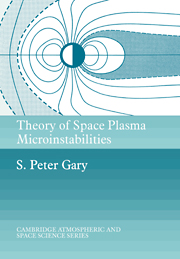Book contents
- Frontmatter
- Contents
- Preface
- 1 Introduction
- 2 Electrostatic waves in uniform plasmas
- 3 Electrostatic component/component instabilities in uniform plasmas
- 4 Electrostatic drift instabilities in inhomogeneous plasmas
- 5 Electromagnetic fluctuations in uniform plasmas
- 6 Electromagnetic waves in uniform plasmas
- 7 Electromagnetic temperature anisotropy instabilities in uniform plasmas
- 8 Electromagnetic component/component instabilities in uniform plasmas
- Appendix A The plasma dispersion function
- Appendix B Unperturbed orbits
- Appendix C Integral evaluation
- Index of symbols
- Index
4 - Electrostatic drift instabilities in inhomogeneous plasmas
Published online by Cambridge University Press: 06 November 2009
- Frontmatter
- Contents
- Preface
- 1 Introduction
- 2 Electrostatic waves in uniform plasmas
- 3 Electrostatic component/component instabilities in uniform plasmas
- 4 Electrostatic drift instabilities in inhomogeneous plasmas
- 5 Electromagnetic fluctuations in uniform plasmas
- 6 Electromagnetic waves in uniform plasmas
- 7 Electromagnetic temperature anisotropy instabilities in uniform plasmas
- 8 Electromagnetic component/component instabilities in uniform plasmas
- Appendix A The plasma dispersion function
- Appendix B Unperturbed orbits
- Appendix C Integral evaluation
- Index of symbols
- Index
Summary
Every plasma is inhomogeneous to some extent, and the associated plasma gradients are sources of free energy that can drive plasma instabilities. In this chapter we consider the linear theory of drift instabilities, modes driven unstable by a plasma gradient perpendicular to B0.
In the direction parallel to a magnetic field, pressure gradients give rise to electric fields that lead to currents and bulk plasma motion; that is, such gradients do not correspond to a steady-state description under a macroscopic description of the plasma. However, pressure gradients perpendicular to a magnetic field can correspond to a steady-state situation; that is, ∇P in the momentum equation of a one-fluid description of the plasma can be balanced by the J × B0/c term. Nevertheless, such gradients do not correspond to an equilibrium plasma configuration; the zeroth-order distribution functions are non-Maxwellian and lead to the growth of plasma instabilities which act to dissipate the gradients. In this chapter we consider, as before, collisionless plasmas with a uniform zeroth-order magnetic field B0 = ẑB0. In Section 4.1 we discuss a model distribution function for density gradients perpendicular to a uniform magnetic field, examine the associated linear dispersion equation and discuss the two most popular density drift instabilities. Section 4.2 describes the instability properties that result when a plasma with a density gradient is subject to a uniform acceleration, and Section 4.3 briefly summarizes some properties of temperature drift instabilities.
- Type
- Chapter
- Information
- Theory of Space Plasma Microinstabilities , pp. 67 - 85Publisher: Cambridge University PressPrint publication year: 1993



